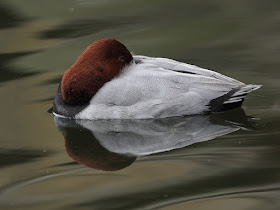A Wood Pigeon climbed through a multiflora rose bush to get at the fruit.
A fallen kerb block at the Peter Pan waterfront is a place for Feral Pigeons to bathe and socalise.
By the Dell restaurant one of their number had fallen to Pigeon Eater. Again he was finishing the last scraps, which he usually doesn't bother with. Evidently he had eaten a lot of it, abandoned it, and then felt hungry again and come back for a second helping.
His rival watched him from a safe distance of 25 feet.
A Common Gull on the Round Pond yawned.
The adult Grey Heron which is presumably a parent of the three latest young ones was preening in the nest.
Young herons of various generations are now scattered through the park and you can't tell them apart any more.
More Jays are appearing after their autumn session of burying acorns. This one was on a fallen trunk north of the Flower Walk.
It was a chilly misty morning and the Little Owl at the Round Pond was staying in her hole.
A flock of Long-Tailed Tits was busy in a dead hawthorn at the northwest corner of the bridge, a dark place where you can't get a good picture.
They were accompanied by a Wren. It's usual for other tits and warblers to follow the flock but I haven't seen a Wren do it before.
A teenage Great Crested Grebe on the Long Water was quietly fishing along with its father. They are growing up.
The various drakes are now all looking their best, from the gaudiness of a Shoveller ...
... and the slightly more restrained plumage of a Mallard ...
... through the cheerful colours of a Common Pochard ...
... and the jaunty black and white of a Tufted Duck ...
... to the tasteful restraint of a Gadwall.
We don't have any Mandarins or Red-Crested Pochards at the moment. They are irregular visitors.
The fox in the willow was settled down to sleep and you could only see the tips of its ears.
The benches along the edge of the Serpentine are in constant need of repair as the exercise maniacs use them as gym equipment.
%20finishing%20pigeon%202024%201a.jpg)
%20and%20rival%202024%201a.jpg)














Lovely duck (or should that be drake?) profiles. Great colour given the dismal conditions.
ReplyDeleteIn some ways it's easier to photograph bright birds in subdued light. In sunlight the white bits tend to flare beyond the ability of a picture editing program to bring them back. The human eye, or rather the human brain editing the perceived image, makes allowances in a way that electronic gizmos have yet to achieve.
DeleteNow that you mention it - I have always wondered why film appears to be able to catch phenomena that are invisible to the eye. I'm thinking of very famous ghost pictures, for instance.
DeleteI see Pigeon Eater is already well into his winter uniform. He's prettier in summer, but still very elegant.
Lovely duck catwalk!
Tinúviel
I strongly suspect that all ghost pictures are either accidental double exposures or deliberate fakes. I just don't believe in spirits registering on film.
Delete